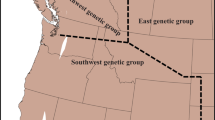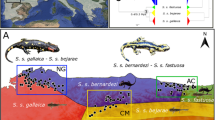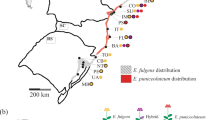Abstract
Examining the frequency and distribution of hybrids across contact zones provide insights into the factors mediating hybridization. In this study, we examined the effect of habitat and climate on hybridization patterns for three phenotypically, genetically, and ecologically distinct groups of the Canada jay (Perisoreus canadensis) in a secondary contact zone in western North America. Additionally, we tested whether the frequency of hybridization involving the three groups (referred to as Boreal, Pacific and Rocky Mountain morphotypes) is similar across the hybrid zones or whether some pairs have hybridized more frequently than others. We reanalyzed microsatellite, mtDNA and plumage data, and new microsatellite and plumage data for 526 individuals to identify putative genetic and phenotypic hybrids. The genetically and phenotypically distinct groups are associated with different habitats and occupy distinct climate niches across the contact zone. Most putative genetic hybrids (86%) had Rocky Mountain ancestry. Hybrids were observed most commonly in intermediate climate niches and in habitats where Engelmann spruce (Picea engelmannii) overlaps broadly with boreal and subalpine tree species. Our finding that hybrids occupy intermediate climate niches relative to parental morphotypes matches patterns for other plant and animal species found in this region. This study demonstrates how habitat and climate influence hybridization patterns in areas of secondary contact and adds to the growing body of research on tri-species hybrid zones.
This is a preview of subscription content, access via your institution
Access options
Subscribe to this journal
Receive 12 print issues and online access
$259.00 per year
only $21.58 per issue
Buy this article
- Purchase on Springer Link
- Instant access to full article PDF
Prices may be subject to local taxes which are calculated during checkout







Similar content being viewed by others
Data availability
All data have been archived in the Dryad Digital Repository https://doi.org/10.5061/dryad.vmcvdnd05.
References
Adams RV, Burg TM (2015) Gene flow of a forest-dependent bird across a fragmented landscape. PLoS One 10:1–22
Aguillon S, Rohwer V (2022) Revisiting a classic hybrid zone: movement of the northern flicker hybrid zone in contemporary times. Evolution 76:1082–1090
Aktas C (2020) Manipulating DNA sequences and estimating unambiguous haplotype network with statistical parsimony. https://cran.r-project.org.
Arboghast BS, Kenagy G (2001) Phylogeography as an integrative comparative phylogeography approach to historical biogeography. J Biogeogr 28:819–825
Behm JE, Ives AR, Boughman JW (2010) Breakdown in postmating isolation and the collapse of a species pair through hybridization. Am Nat 175:11–26
Bell RC, Irian CG (2019) Phenotypic and genetic divergence in reed frogs across a mosaic hybrid zone on São Tomé Island. Biol J Linn Soc 128:672–680
Bensch S, Price T, Kohn J (1997) Isolation and characterization of microsatellite loci in a Phyloscopus warbler. Mol Ecol 6:91–92
Billerman SM, Cicero C, Bowie RCK, Carling MD (2019) Phenotypic and genetic introgression across a moving woodpecker hybrid zone. Mol Ecol 28:1692–1708
Billerman SM, Murphy MA, Carling MD (2016) Changing climate mediates sapsucker (Aves: Sphyrapicus) hybrid zone movement. Ecol Evol 6:7976–7990
Boecklen WJ (2017) Topology of syngameons. Ecol Evol 7:10486–10491
Borge T, Lindroos K, Nádvorník P, Syvänen AC, Sætre GP (2005) Amount of introgression in flycatcher hybrid zones reflects regional differences in pre and post-zygotic barriers to gene exchange. J Evol Biol 18:1416–1424
Brunsfeld SJ, Sullivan J, Soltis DE, Soltis PS (2000) Comparative phylogeography of north-western North America: a synthesis. In: Silvertown J, Antonovics J (eds) Integrating Ecology and Evolution in a Spatial Context. Blackwell Science, Oxford
Buerkle CA (2005) Maximum-likelihood estimation of a hybrid index based on molecular markers. Mol Ecol Notes 5:684–687
Busch JD, Benford R, Pearson T, Palmer E, Balda RP, Keim P (2009) Development of polymorphic tetranucleotide microsatellites for pinyon jays (Gymnorhinus cyanocephalus). Conserv Genet 10:689–691
Cannon CH, Petit RJ (2020) The oak syngameon: more than the sum of its parts. New Phytol 226:978–983
Chavez AS, Saltzberg CJ, Kenagy GJ (2011) Genetic and phenotypic variation across a hybrid zone between ecologically divergent tree squirrels (Tamiasciurus). Mol Ecol 20:3350–3366
Chhatre VE, Evans LM, DiFazio SP, Keller SR (2018) Adaptive introgression and maintenance of a trispecies hybrid complex in range-edge populations of Populus. Mol Ecol 27:4820–4838
Clement M, Posada D, Crandall K (2002) TCS: a computer program to estimate gene geaneologies. Mol Ecol 9:1657–1660
Costa D, Sotelo G, Kaliantzopoulou A, Carvalho J, Butlin R, Hollander J, Faria R (2020) Hybridization patterns between two marine snails, Littorina fabalis and L. obtusa. Ecol Evol 10:1058–1079
Cronk QC, Suarez-Gonzalez A (2018) The role of interspecific hybridization in adaptive potential at range margins. Mol Ecol 27:4653–4656
Crow KD, Munehara H, Kanamoto Z, Balanov A, Antonenko D, Bernardi G (2007) Maintenance of species boundaries despite rampant hybridization between three species of reef fishes (Hexagrammidae): Implications for the role of selection. Biol J Linn Soc 91:135–147
Delaney KS, Wayne RK (2005) Adaptive units for conservation: population distinction and historic extinctions in the island scrub-jay. Conserv Biol 19:523–533
De La Torre AR, Ingvarsson PK, Aitken SN (2015) Genetic architecture and genomic patterns of gene flow between hybridizing species of Picea. Heredity 115:153–164
De La Torre AR, Roberts DR, Aitken SN (2014) Genome-wide admixture and ecological niche modelling reveal the maintenance of species boundaries despite long history of interspecific gene flow. Mol Ecol 23:2046–2059
De La Torre AR, Wang T, Jaquish B, Aitken SN (2014) Adaptation and exogenous selection in a Picea glauca × Picea engelmannii hybrid zone: Implications for forest management under climate change. New Phytol 201:687–699
De Zwaan DR, Mackenzie J, Mikklesen E, Wood C, Wang S (2021) Opposing dominance within a color gene block underpins hybrid plumage signal discordance.
Dohms KM, Graham BA, Burg TM (2017) Multilocus genetic analyses and spatial modeling reveal complex population structure and history in a widespread resident North American passerine (Perisoreus canadensis). Ecol Evol 7:9869–9889
Funk ER, Taylor SA (2019) High-throughput sequencing is revealing genetic associations with avian plumage color. The Auk 136:1–7
Gompert Z, Mandeville EG, Buerkle CA (2017) Analysis of population genomic data from hybrid zones. Annu Rev Ecol Evol Syst 48:207–229
Grabenstein KC, Taylor SA (2018) Breaking barriers: causes, consequences, and experimental utility of human-mediated hybridization. Trends Ecol Evol 33:198–212
Graham BA, Burg TM (2012) Molecular markers provide insights into contemporary and historic gene flow for a non-migratory species. J Avian Biol 43:198–214
Graham BA, Cicero C, Strickland D, Woods JG, Coneybeare H, Dohms KM et al. (2021) Cryptic genetic diversity and cytonuclear discordance characterize contact among Canada jay (Perisoreus canadensis) morphotypes in western North America. Biol J Linn Soc 132:725–740
Grant V (1981) The Syngameon. In: Plant Speciation. New York, NY, Columbia University Press, p 234–241
Grant PR, Grant BR (2020) Triad hybridization via a conduit species. Proc Natl Acad Sci USA 117:7888–7896
Griffith SC, Stewart IRK, Dawson DA, Owens IPF, Burke T (1999) Contrasting patterns of extra-pair paternity in mainland and island populations of the house sparrow (Passer domesticus): Is there an ‘island effect’? Biol J Linn Soc 68:303–316
Grossen C, Seneviratne SS, Croll D, Irwin DE (2016) Strong reproductive isolation and narrow genomic tracts of differentiation among three woodpecker species in secondary contact. Mol Ecol 25:4247–4266
Gugger PF, Sugita S, Cavender-Bares J (2010) Phylogeography of Douglas-fir based on mitochondrial and chloroplast DNA sequences: testing hypotheses from the fossil record. Mol Ecol 19:1877–1897
Hamilton JA, De la Torre AR, Aitken SN (2015) Fine-scale environmental variation contributes to introgression in a three-species spruce hybrid complex. Tree Genet Genomes 11:817
Hammer Ø, Harper DA, Ryan PD (2001) Paleontological statistics software package for education and data analysis. Palaeontol Electron 4:9
Haselhorst MSH, Parchman TL, Buerkle CA (2019) Genetic evidence for species cohesion, substructure and hybrids in spruce. Mol Ecol 28:2029–2045
Hewitt G (1988) Hybrid zones-natural laboratories for evolutionary studies. Trends Ecol Evol 3:158–167
Hijmans RJ, Cameron SE, Parra JL, Jones PG, Jarvis A (2005) Very high resolution interpolated climate surfaces for global land areas. Int J Climatol 25:1965–1978
Irwin DE (2020) Assortative mating in hybrid zones is remarkably Ineffective in promoting speciation. Evolution 195:E150–E167
Jasso-Martínez JM, Machkour-M’Rabet S, Vila R, Rodríguez-Arnaiz R, Castañeda-Sortibrán AN (2018) Molecular evidence of hybridization in sympatric populations of the Enantia jethys complex (Lepidoptera: Pieridae). PLoS One 13:1–23
Kovach RP, Muhlfeld CC, Boyer MC, Lowe WH, Allendorf FW, Luikart G (2015) Dispersal and selection mediate hybridization between a native and invasive species. Proc R Soc B 282:20142454
Lemmon EM, Lemmon AR (2010) Reinforcement in chorus frogs: lifetime fitness estimates including intrinsic natural selection and sexual selection against hybrids. Evolution 64:1748–1761
Li SH, Huang Y, Brown J (1997) Isolation of tetranucleotide microsatellites from the Mexican jay Aphelcoma ultramarina. Mol Ecol 6:499–501
Mallet J (2005) Hybridization as an invasion of the genome. Trends Ecol Evol 20:229–237
McDonald DB, Potts WK (1994) Cooperative display and relatedness among males in a lek-mating bird. Science 266:1030–1032
McKenzie JL, Dhillon RS, Schulte PM, McKenzie JL (2015) Evidence for a bimodal distribution of hybrid indices in a hybrid zone with high admixture. R Soc Open Sci 2:150285
Meirmans PG, Van Tienderen PH (2004) GENOTYPE and GENODIVE: two programs for the analysis of genetic diversity of asexual organisms. Mol Ecol Notes 4:792–794
Moran PA, Hunt J, Mitchell C, Ritchie MG, Bailey NW (2019) Behavioural mechanisms of sexual isolation involving multiple modalities and their inheritance. J Evol Biol 32:243–258
Natola L, Burg TM (2018) Population genetics and speciation of yellow-bellied, red-naped, and red-breasted sapsuckers (Sphyrapicus varius, S. nuchalis, and S. ruber). J Hered 109:663–674
Natola L, Seneviratne S, Irwin D (2022) Population genomics of an emergent tri-species hybrid zone. Mol Ecol 31:5356–5367
Nielsen E, Bach L, Kotlicki P (2006) HYBRIDALB (version 1.0): a program for generating simulated hybrids from population samples. Mol Ecol Notes 6:971–973
Ortego J, Gugger PF, Riordan EC, Sork VL (2014) Influence of climatic niche suitability and geographical overlap on hybridization patterns among southern Californian oaks. J Biogeogr 41:1895–1908
Ottenburghs J (2021) The genic view of hybridization in the Anthropocene. Evol Appl 14:2342–2360
Potvin DA, Clegg SM (2015) The relative roles of cultural drift and acoustic adaptation in shaping syllable repertoires of island bird populations change with time since colonization. Evolution 69:368–380
Pritchard JK, Stephens M, Donnelly P (2000) Inference of population structure using multilocus genotype data. Genetics 155:945–959
Quarrell NJ, Strickland D, Norris DR (2022) Investigating factors that set the lower elevational limit of Canada jays (Perisoreus canadensis) on Vancouver Island, British Columbia, Canada. Can J Zool 100:64–76
Rice W (1989) Analyzing tables of statistical tests. Evolution 43:223–225
Rieseberg LH (1997) Hybrid origins of plant species. Annu Rev Ecol Syst 28:359–389
Rousset F (2008) GENEPOP’007: a complete re-implementation of the GENEPOP software for Windows and Linux. Mol Ecol Resour 8:103–106
Ruegg K, Slabbekoorn H, Clegg S, Smith TB (2006) Divergence in mating signals correlates with ecological variation in the migratory songbird, Swainson’s thrush (Catharus ustulatus). Mol Ecol 15:3147–3156
Seehausen O, Takimoto G, Roy D, Jokela J (2008) Speciation reversal and biodiversity dynamics with hybridization in changing environments. Mol Ecol 17:30–44
Seneviratne SS, Toews DPL, Brelsford A, Irwin DE (2012) Concordance of genetic and phenotypic characters across a sapsucker hybrid zone. J Avian Biol 43:119–130
Slager DL, Epperley KL, Ha RR, Rowher S, Woods C, Van Hemert C, Klicka J (2020) Cryptic and extensive hybridization between ancient lineages of American crows. Mol Ecol 29:959–969
Soltis PS, Soltis DE (2009) The role of hybridization in plant speciation. Annu Rev Plant Biol 60:561–588
Stenzler LM, Fitzpatrick JW (2002) Isolation of microsatellite loci in the Florida scrub-jay Aphelcoma coerulescens. Mol Ecol Notes 2:547–550
Strickland DS, Ouellet H (2020) Canada jay (Perisoreus canadensis), version 1.0. In Birds of the World.
Swenson NG, Howard DJ (2005) Clustering of contact zones, hybrid zones, and phylogeographic breaks in North America. Am Nat 166:581–591
Tarr CL, Fleisher RC (1998) Primers for polymorphic GT microsatellites isolated from the Mariana crow, Corvus kabaryi. Mol Ecol 7:252–255
Taylor EB, Boughman JW, Groenenboom M, Sniatynski M, Schluter D, Gow JL (2006) Speciation in reverse: morphological and genetic evidence of the collapse of a three-spined stickleback (Gasterosteus aculeatus) species pair. Mol Ecol 15:343–55
Taylor SA, Larson EL, Harrison RG (2015) Hybrid zones: windows on climate change. Trends Ecol Evol 30:398–406
Taylor SA, White TA, Hochachka WM, Ferretti V, Curry RL, Lovette I (2014) Climate-mediated movement of an avian hybrid zone. Curr Biol 24:671–676
Tea YK, Hobbs JPA, Vitelli F, DiBattista JD, Ho SYW, Lo N (2020) Angels in disguise: sympatric hybridization in the marine angelfishes is widespread and occurs between deeply divergent lineages. Proc Biol Sci 287:20201459
Toews DPL, Iewin DE (2008) Cryptic specieation in a holarctic passerine revelaed by genetic and bioacoustic analyses. Mol Ecol 17:2691–2705
Toews DPL, Brelsford A, Irwin DE (2011) Hybridization between Townsend’s Dendroica townsendi and black-throated green warblers D. virens in an avian suture zone. J Avian Biol 42:434–446
Vaha JP, Primmer CR (2006) Efficiency of model based Bayesian methods for detecting hybrid individuals under different hybridization scenarios with different number of loci. Mol. Ecol. 15:63–72
Väli U, Saag P, Dombrovsky V, Meyburg BU, Maciorowski G, Mizera T, Treinys R, Fagerberg S (2010) Microsatellite and single nucleotide polymorphisms in avian hybrid identification: a comparative case study. J. Avian Biol. 41:34–49
van Dam A, Dekker M, Morales-Castilla I, Rodríguez M, Wichmann D, Baudena M (2021) Correspondence analysis, spectral clustering and graph embedding: Applications to ecology and economic complexity. Sci Rep 11:8926
van Els P, Cicero C, Klicka J (2012) High latitudes and high genetic diversity: Phylogeography of a widespread boreal bird, the gray jay (Perisoreus canadensis). Mol Phylogenet Evol 63:456–465
Wang S, Rohwer S, Delmore K, Irwin DE (2019) Cross-decades stability of an avian hybrid zone. J Evol Biol 32:1242–1251
Weir JT, Schluter D(2004) Ice sheets promote speciation in birds Proc Roy Soc B Biol Sci 271:1881–1885
Wielstra B (2019) Historical hybrid movement: more pervasive than appreciated. J Biogeography 46:1300–1305
Wood EM, Barker Swarthout SE, Hochachka WM, Larkin JL, Rohrbaugh RW, Rosenberg KV et al. (2016) Intermediate habitat associations by hybrids may facilitate genetic introgression in a songbird. J Avian Biol 47:508–520
Acknowledgements
We thank all of the field assistants and graduate students that assisted with field sample collection, and Quinn McCallum and Fei Ying who helped with data collection for the museum samples. We thank the Burke Museum, American Museum of Natural History, Royal Saskatchewan Museum, Royal Alberta Museum, Beaty Biodiversity Museum, Royal British Columbia Museum, Royal Ontario Museum and Canadian Museum of Nature for tissue and specimen loans.
Funding
This work was funded by NSERC Discovery and Alberta Innovates grants (TMB). All methods and procedures were approved by the University of Lethbridge Animal Welfare Committee (#1901).
Author information
Authors and Affiliations
Contributions
BAG collected samples from the field, collected data from museum skins, genotyped samples, analyzed all the data, and wrote and edited the manuscript. IS collected data from museum skins and edited the manuscript. CC collected samples from the field, collected data from museum skins, and edited the manuscript. DS collected data from museum skins and edited the manuscript. JW collected data from museum skins and edited the manuscript. HC drew the sketches of Canada Jay and tree species featured in the figures, collected data from museum skins, and edited the paper. KMD collected samples from the field, genotyped samples, and edited the manuscript. TMB collected samples from the field, collected data from museum skins, assisted with the writing of the manuscript, edited the manuscript, and was responsible for securing funding for the project.
Corresponding author
Ethics declarations
Competing interests
The authors declare no competing interests.
Additional information
Publisher’s note Springer Nature remains neutral with regard to jurisdictional claims in published maps and institutional affiliations.
Associate editor: Rui Faria
Supplementary information
41437_2023_652_MOESM1_ESM.docx
Habitat and climate influence hybridization among three genetically distinct Canada jay (Perisoreus canadensis) morphotypes in an avian hybrid zone complex
Rights and permissions
Springer Nature or its licensor (e.g. a society or other partner) holds exclusive rights to this article under a publishing agreement with the author(s) or other rightsholder(s); author self-archiving of the accepted manuscript version of this article is solely governed by the terms of such publishing agreement and applicable law.
About this article
Cite this article
Graham, B.A., Szabo, I., Cicero, C. et al. Habitat and climate influence hybridization among three genetically distinct Canada jay (Perisoreus canadensis) morphotypes in an avian hybrid zone complex. Heredity 131, 361–373 (2023). https://doi.org/10.1038/s41437-023-00652-3
Received:
Revised:
Accepted:
Published:
Issue Date:
DOI: https://doi.org/10.1038/s41437-023-00652-3



